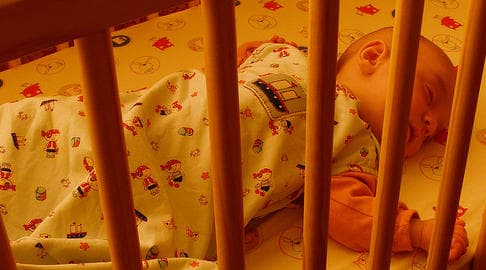Norway study may answer cot-death riddle

A team of Norwegian researchers believes may be on the way to solving the riddle of Sudden Infant Death Syndrome (Sids) or 'cot-death', opening the way to screening and even treatment.
"If you know the mechanism, it's always possible to develop some drugs or some therapy," Professor Torleif Rognum, who is leading the research project at the University of Oslo, told The Local. "One might perhaps screen for it, but the main thing is that you develop some strategy to counter it." Sids, the sudden and up until now unexplained death of babies in the first year of their lives, is one of the leading causes of infant mortality in the west. The department of forensic medicine, which Rognum heads, suspects that oversized water channels in the brains of infants susceptible to sids allow their brains to swell with water, leading to sudden death. "It's a new theory concerning the final pathway in death in sids," he said. "It's only ten to 15 years since people really started to study these small water channels. It's part of normal genetic variation, but under certain unlucky circumstances it may be dangerous to sids kids." Rognum's colleague Siri Opdal published a study in 2010showing that sids babies were more likely to carry an unusual variant of a gene, called Aquaporin Four, which influences water channel formation. The forensic medicine department, which is responsible for carrying out autopsies on all Norway's Sids cases, is now analysing the brains of the country's sids babies to see if their theory is correct. They have now shown that sids babies' brains tend to be heavier than average. "They have higher brain-weight to body-weight rations," Rognum said. "But we want to go directly into the water content of the brain, to see if it really swells, or if there is some other reason for the weight." Tragically, many women were in the 1990s convicted of murdering their infants, after doctors told courts that it was statistically unfeasible that a mother could see two babies die in infancy. "You had these American forensic pathologists who say one infant death is a tragedy, two is suspicious and three is murder," said Rognum. "But that's too simple, there are some genetic factors." He hopes to publish his conclusions next year.
Comments
See Also
"If you know the mechanism, it's always possible to develop some drugs or some therapy," Professor Torleif Rognum, who is leading the research project at the University of Oslo, told The Local. "One might perhaps screen for it, but the main thing is that you develop some strategy to counter it."
Sids, the sudden and up until now unexplained death of babies in the first year of their lives, is one of the leading causes of infant mortality in the west.
The department of forensic medicine, which Rognum heads, suspects that oversized water channels in the brains of infants susceptible to sids allow their brains to swell with water, leading to sudden death.
"It's a new theory concerning the final pathway in death in sids," he said. "It's only ten to 15 years since people really started to study these small water channels. It's part of normal genetic variation, but under certain unlucky circumstances it may be dangerous to sids kids."
Rognum's colleague Siri Opdal published a study in 2010showing that sids babies were more likely to carry an unusual variant of a gene, called Aquaporin Four, which influences water channel formation.
The forensic medicine department, which is responsible for carrying out autopsies on all Norway's Sids cases, is now analysing the brains of the country's sids babies to see if their theory is correct.
They have now shown that sids babies' brains tend to be heavier than average.
"They have higher brain-weight to body-weight rations," Rognum said. "But we want to go directly into the water content of the brain, to see if it really swells, or if there is some other reason for the weight."
Tragically, many women were in the 1990s convicted of murdering their infants, after doctors told courts that it was statistically unfeasible that a mother could see two babies die in infancy.
"You had these American forensic pathologists who say one infant death is a tragedy, two is suspicious and three is murder," said Rognum. "But that's too simple, there are some genetic factors."
He hopes to publish his conclusions next year.
Join the conversation in our comments section below. Share your own views and experience and if you have a question or suggestion for our journalists then email us at [email protected].
Please keep comments civil, constructive and on topic – and make sure to read our terms of use before getting involved.
Please log in here to leave a comment.